Digital Modes
The following programs need the Matlab Compiler Runtime (MCR) to be installed.
MSRX V5.0
MSRX is a receiver for meteor scatter for use parallel to WSJT.
In contrast to WSJT the confidence of the decoded characters is encoded in the visibility
(bold black for high confidence, light gray for low confidence.
Additionally MSRX also decodes PSK2k.
Therefore you could use FSK441 to reply to a CQ received in PSK2k.
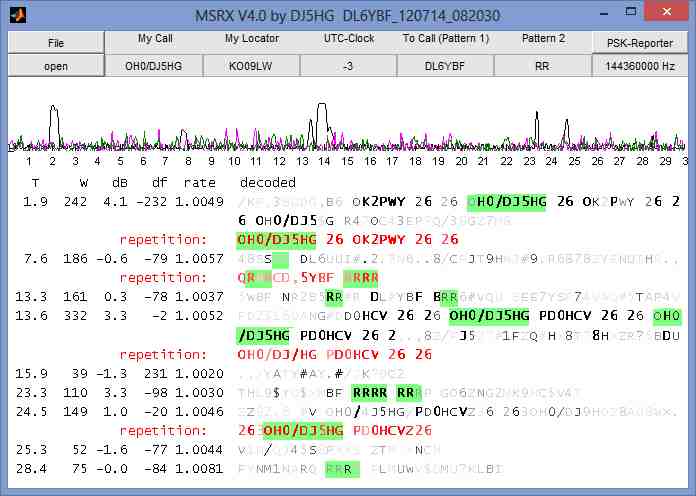 Download MSRX_UserGuide (280 kB)
Download MSRX.zip (4 MB)
MSRX V5 has the new option to correlate the input signal with a given pattern.
MSRX V5 has the option to simulate meteorscatter signals very near to reality.
An example is here:
Download sim_example_1.wav (320 kB)
MSRX V4.0 decodes it to (which makes the great difference between FSK441 and PSK2k visible):
Download MSRX_UserGuide (280 kB)
Download MSRX.zip (4 MB)
MSRX V5 has the new option to correlate the input signal with a given pattern.
MSRX V5 has the option to simulate meteorscatter signals very near to reality.
An example is here:
Download sim_example_1.wav (320 kB)
MSRX V4.0 decodes it to (which makes the great difference between FSK441 and PSK2k visible):
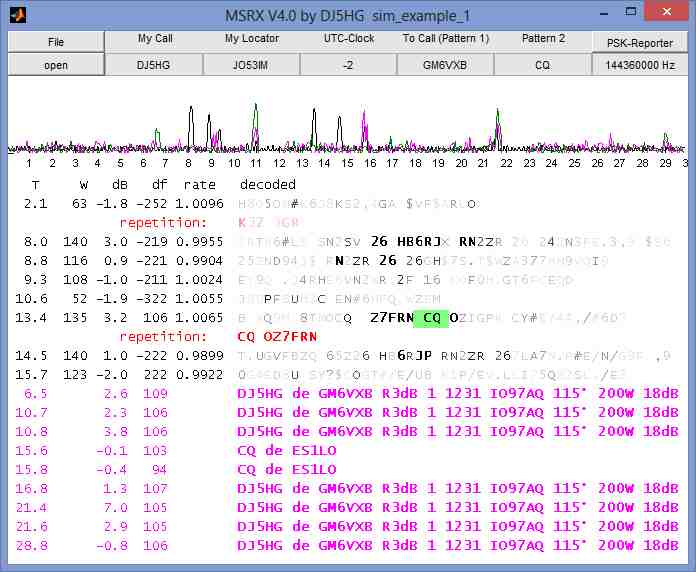 A further example is the decoding of some recordings at my holiday location in OH0:
Download OH0-Decodings (710 kB)
.
A further example is the decoding of some recordings at my holiday location in OH0:
Download OH0-Decodings (710 kB)
.
.
PSK2k V8.5
PSK2k is an advanced digital mode for meteor scatter with secure communication by Error Correcting and Error Detecting Codes.
Auto-Modes for automatic QSO running and automatic reply to received calls are integrated.
This program can operate in parallel to WSJT on the same PC on the same soundcard.
So you decode FSK441 and PSK2k on the frequency in use.
PSK2k can automatically send reports to the
PSK-Reporter Map
(set the parameters to: 2m / signals / sent rcvd by / anyone / / PSK2k then click GO
An example is here:
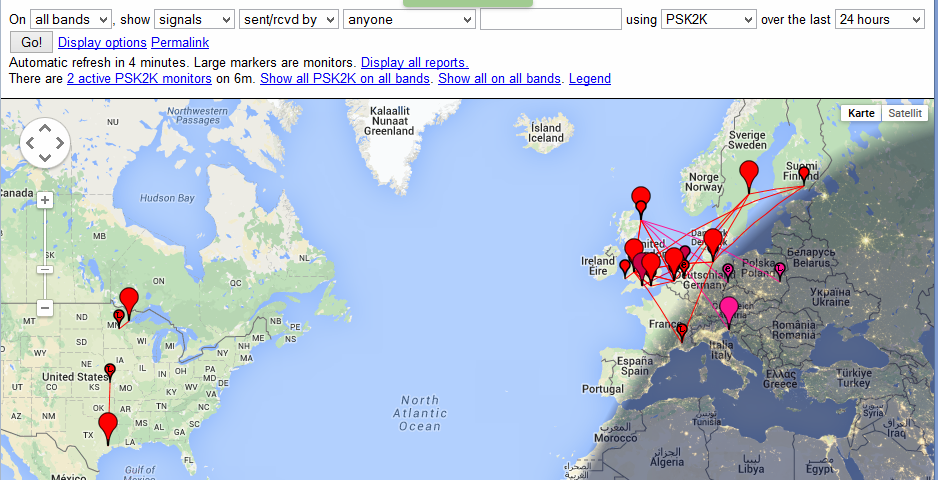
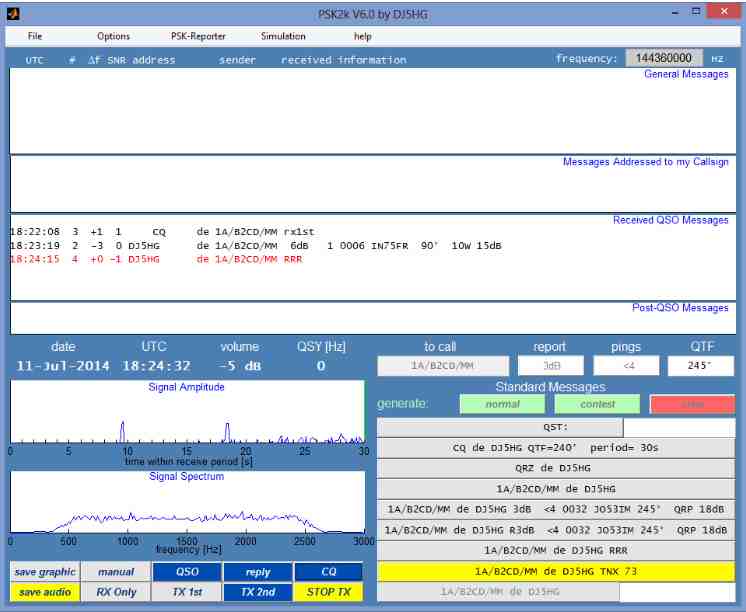 PSK2k can decode very weak signals. Here an example which has two pings at seconds 3 and 8.
After automatic accumulation of both pings the decode is CQ de DJ5HG QTF=rndH period= 15s rx1st *6
Download weakping.wav (100 kB)
Download PSK2k_UserGuide.pdf (460 kB)
Download PSK2k_Documentation.pdf (320 kB)
Some Comments on Reliability and Validity of PSK2k-QSOs
Compared to V8.4, V8.5 removes problems with the QSO-automatic.
PSK2k V8.5 is available with two different Application Programming Interfaces (API) to the sound devices.
Both should work on all Windows systems. Try the other if there are problems with the sound devices.
The PSK-reporter function throws an error on some systems. This is not a bug in PSK2k. Nevertheless,
please report to DJ5HG. May be we can find a workaround.
Download version 8.5 with Wndows DirectSound API as psk2k_2011a_ds.zip
Download version 8.5 with Wndows WDM-KS API as psk2k_2011a_wdmks.zip
The 64 bit compilation of PSK2k V8.5 still runs into a registry error with the asyncio.
It needs the Matlab Compiler Runtime 64 bit 2015a which is avalable on the root download page.
The compilation of PSK2k 64 bit is here:
Download 64 bit version 8.5 with Wndows DirectSound API as psk2k_2015a_ds.zip
Download 64 bit version 8.5 with Wndows WDM-KS API as psk2k_2015a_wdmks.zip
PSK2k can decode very weak signals. Here an example which has two pings at seconds 3 and 8.
After automatic accumulation of both pings the decode is CQ de DJ5HG QTF=rndH period= 15s rx1st *6
Download weakping.wav (100 kB)
Download PSK2k_UserGuide.pdf (460 kB)
Download PSK2k_Documentation.pdf (320 kB)
Some Comments on Reliability and Validity of PSK2k-QSOs
Compared to V8.4, V8.5 removes problems with the QSO-automatic.
PSK2k V8.5 is available with two different Application Programming Interfaces (API) to the sound devices.
Both should work on all Windows systems. Try the other if there are problems with the sound devices.
The PSK-reporter function throws an error on some systems. This is not a bug in PSK2k. Nevertheless,
please report to DJ5HG. May be we can find a workaround.
Download version 8.5 with Wndows DirectSound API as psk2k_2011a_ds.zip
Download version 8.5 with Wndows WDM-KS API as psk2k_2011a_wdmks.zip
The 64 bit compilation of PSK2k V8.5 still runs into a registry error with the asyncio.
It needs the Matlab Compiler Runtime 64 bit 2015a which is avalable on the root download page.
The compilation of PSK2k 64 bit is here:
Download 64 bit version 8.5 with Wndows DirectSound API as psk2k_2015a_ds.zip
Download 64 bit version 8.5 with Wndows WDM-KS API as psk2k_2015a_wdmks.zip
.
SlowPSK V2.2 (PSK21) and EMEpsk V1.14
SlowPSK is an advanced digital mode for weak signal communication below -28 dB.
The program is now is ready for general use. But there surely are some bugs.
Especially the periods larger than 1 minute are not exhaustibly tested.
These programs will be replaced by superPSK this year which even is more sensitive.
Nige, G7CNF, proposes some frequencies for SlowPSK: 1837, 3578, 7038, 10138, 14068, 18098, 21068, 24918, 28118, 50238, 70103.
For a first try, simply monitor 14068 kHz dial frequency.
The following image shows a QSO made on 14068 kHz made with 5W at RV3APM and with
0.5 W at DJ5HG. QSOs with even 0.1 W succeeded.
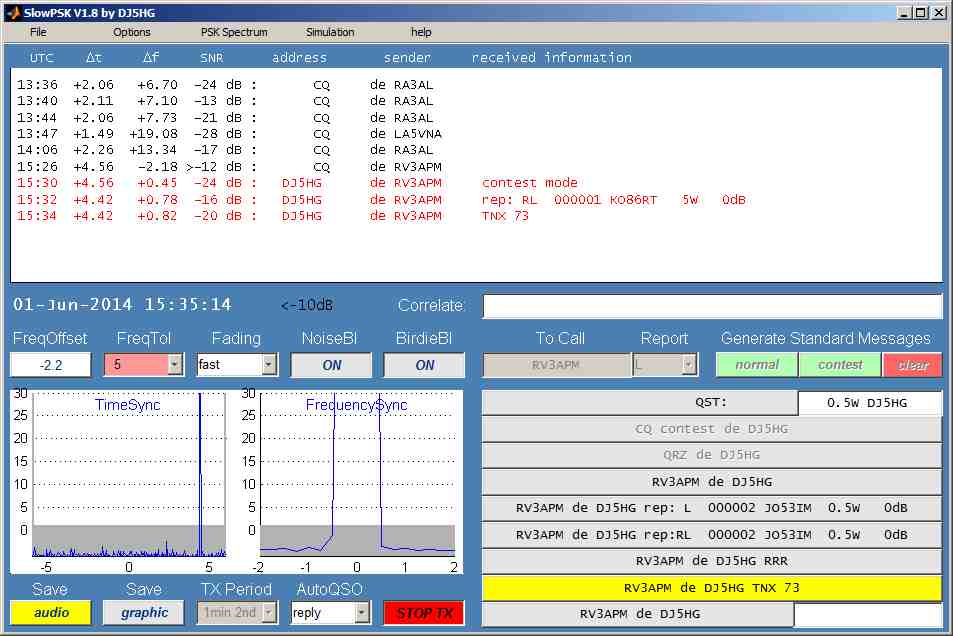 The new specifications and UserGuides are here:
Download SlowPSK_UserGuide.pdf (315 kB)
Download Documentation for SlowPSK and EMEpsk (170 kB)
Download actual version of SlowPSK (includes the actual UserGuide)
The new specifications and UserGuides are here:
Download SlowPSK_UserGuide.pdf (315 kB)
Download Documentation for SlowPSK and EMEpsk (170 kB)
Download actual version of SlowPSK (includes the actual UserGuide)
 Download EMEpsk_UserGuide.pdf (60 kB)
Download actual version of EMEpsk (includes the actual UserGuide)
The documentation of EMEpsk is included in the Documentation of SlowPSK.
.
Download EMEpsk_UserGuide.pdf (60 kB)
Download actual version of EMEpsk (includes the actual UserGuide)
The documentation of EMEpsk is included in the Documentation of SlowPSK.
.
.
Dimosaur
DIgital MOde for Spreading AUrora (Dimosaur) is a relatively fast mode for radio channels with great
frequency spreading as in aurora, rain scatter, FAI etc.. The transmission length is 8 seconds.
So Dimosaur is as fast as CW and well adapted to rapidly changing conditions.
Dimosaur is in the final phase of debugging.
.
.
HDCW V2.2
HDCW was designed as an RTTY-type mode for use on radio channels with great frequency spreading as in aurora.
Indeed, in case of aurora-signals HDCW is more sensitive than any human CW-operator at the same speed.
If the frequency spreading is as low such that PSK31 decodes, then these coherent digital modes outperform HDCW.
But also on none-spreading channels HDCW may be very useful by two reasons:
(1) it is very robust against QRM, and
(2) it decodes all incoming signals within the usual SSB-bandwidth in parallel.
HDCW has the options FSK and ASK (for aurora).
The characterrate can be chosen in a wide range to adapt to the specific application.
The following example shows the result of a very weak simulated aurora signal (-11 dB).
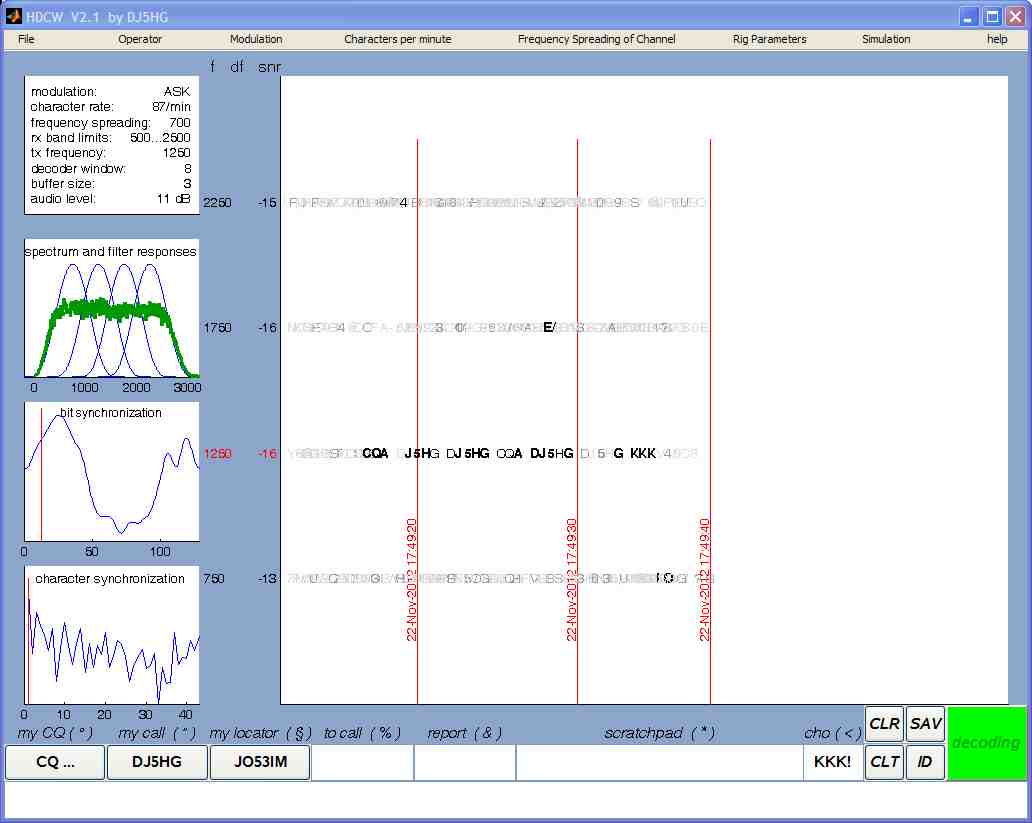 Here two audio examples:
The sound of HDCW in ASK at 87 characters/minute (normal CW-speed, text sent is 'CQ DJ5HG'):
Download HDCW audioexample1 (131 kB)
The sound of HDCW in FSK at 22 characters/minute for non-spreading channels (text sent is 'DJ5HG'):
Download HDCW audioexample2 (406 kB)
Download HDCW_UserManual.pdf (380 kB)
Download Version 2.2 HDCW.zip (6.4 MB, includes the UserManual)
The record of the simulated aurora signal in ASK at 87 characters/minute with SNR=-11 dB is here:
Download HDCW aurora audioexample -11 dB (650 kB)
The same information is sent at the same speed and the same SNR=-11 dB in CW here via the same aurora.
You surely can identify the signal.
aurorafilter
even can dig this signal out of the noise. But reading remains difficult compared to the display of HDCW above:
Download CW aurora audioexample -11 dB (650 kB)
.
Here two audio examples:
The sound of HDCW in ASK at 87 characters/minute (normal CW-speed, text sent is 'CQ DJ5HG'):
Download HDCW audioexample1 (131 kB)
The sound of HDCW in FSK at 22 characters/minute for non-spreading channels (text sent is 'DJ5HG'):
Download HDCW audioexample2 (406 kB)
Download HDCW_UserManual.pdf (380 kB)
Download Version 2.2 HDCW.zip (6.4 MB, includes the UserManual)
The record of the simulated aurora signal in ASK at 87 characters/minute with SNR=-11 dB is here:
Download HDCW aurora audioexample -11 dB (650 kB)
The same information is sent at the same speed and the same SNR=-11 dB in CW here via the same aurora.
You surely can identify the signal.
aurorafilter
even can dig this signal out of the noise. But reading remains difficult compared to the display of HDCW above:
Download CW aurora audioexample -11 dB (650 kB)
.
.
CWP
CWP is a CW-compatible digital mode.
It exactly sounds like CW (hear the audio example below).
The only diffenence is that the carrierphase is inverted at every key-down.
The coherent decoder of CWP therefore can much better differentiate between a dash and two dots than this is possible in normal CW.
Signals at SNR = -20 dB (see the figure) can well be decoded.
The CWP-receiver decodes all signals in a bandwidth of 2000 Hz.
The confidence of the decoded characters is encoded in their visibility.
In the following example the receiver finds two additional signals of very low confidence at a level of -28 dB.
There is only a test version of CWP.
It was programmed just for fun.
Digital modes with Forward-Error-Correction (FEC) like JT65 are more sensitive .
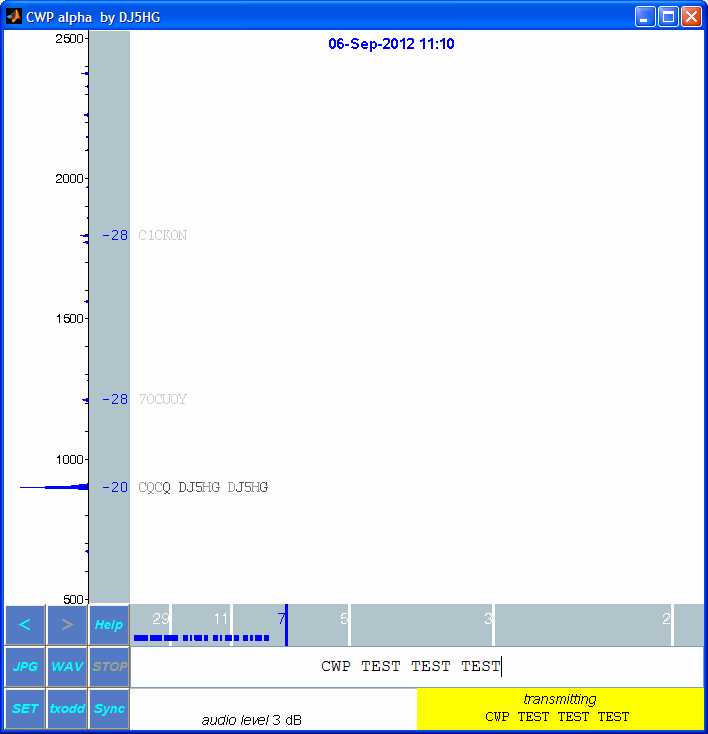 Here the sound of CWP:
Download audioexample of CWP (12s)
Download Version 2.0: cwp_n.zip (4.0 MB)
.
Here the sound of CWP:
Download audioexample of CWP (12s)
Download Version 2.0: cwp_n.zip (4.0 MB)
.
.
FSK441TX
A very simple transmitter for FSK441 as an example of Digital Signal Processing
discussed in CQ-DL Spezial Digital 2011, pp.11-15.
 Download FSK441GUI.zip (120 kB)
The complete Matlab source code is not very large. Here it is for inspection:
Download sourcecode of FSK441TX (40 kB)
.
Download FSK441GUI.zip (120 kB)
The complete Matlab source code is not very large. Here it is for inspection:
Download sourcecode of FSK441TX (40 kB)
.
.
Papers Concerning Digital Modes
Download the VERON Lecture on Digital Modes, Dwingeloo 2007 (3.3 MB)
.
.
back to the Main Page
.
.
 Download MSRX_UserGuide (280 kB)
Download MSRX.zip (4 MB)
MSRX V5 has the new option to correlate the input signal with a given pattern.
MSRX V5 has the option to simulate meteorscatter signals very near to reality.
An example is here:
Download sim_example_1.wav (320 kB)
MSRX V4.0 decodes it to (which makes the great difference between FSK441 and PSK2k visible):
Download MSRX_UserGuide (280 kB)
Download MSRX.zip (4 MB)
MSRX V5 has the new option to correlate the input signal with a given pattern.
MSRX V5 has the option to simulate meteorscatter signals very near to reality.
An example is here:
Download sim_example_1.wav (320 kB)
MSRX V4.0 decodes it to (which makes the great difference between FSK441 and PSK2k visible):
 A further example is the decoding of some recordings at my holiday location in OH0:
Download OH0-Decodings (710 kB)
.
A further example is the decoding of some recordings at my holiday location in OH0:
Download OH0-Decodings (710 kB)
.

 PSK2k can decode very weak signals. Here an example which has two pings at seconds 3 and 8.
After automatic accumulation of both pings the decode is CQ de DJ5HG QTF=rndH period= 15s rx1st *6
Download weakping.wav (100 kB)
Download PSK2k_UserGuide.pdf (460 kB)
Download PSK2k_Documentation.pdf (320 kB)
Some Comments on Reliability and Validity of PSK2k-QSOs
Compared to V8.4, V8.5 removes problems with the QSO-automatic.
PSK2k V8.5 is available with two different Application Programming Interfaces (API) to the sound devices.
Both should work on all Windows systems. Try the other if there are problems with the sound devices.
The PSK-reporter function throws an error on some systems. This is not a bug in PSK2k. Nevertheless,
please report to DJ5HG. May be we can find a workaround.
Download version 8.5 with Wndows DirectSound API as psk2k_2011a_ds.zip
Download version 8.5 with Wndows WDM-KS API as psk2k_2011a_wdmks.zip
The 64 bit compilation of PSK2k V8.5 still runs into a registry error with the asyncio.
It needs the Matlab Compiler Runtime 64 bit 2015a which is avalable on the root download page.
The compilation of PSK2k 64 bit is here:
Download 64 bit version 8.5 with Wndows DirectSound API as psk2k_2015a_ds.zip
Download 64 bit version 8.5 with Wndows WDM-KS API as psk2k_2015a_wdmks.zip
PSK2k can decode very weak signals. Here an example which has two pings at seconds 3 and 8.
After automatic accumulation of both pings the decode is CQ de DJ5HG QTF=rndH period= 15s rx1st *6
Download weakping.wav (100 kB)
Download PSK2k_UserGuide.pdf (460 kB)
Download PSK2k_Documentation.pdf (320 kB)
Some Comments on Reliability and Validity of PSK2k-QSOs
Compared to V8.4, V8.5 removes problems with the QSO-automatic.
PSK2k V8.5 is available with two different Application Programming Interfaces (API) to the sound devices.
Both should work on all Windows systems. Try the other if there are problems with the sound devices.
The PSK-reporter function throws an error on some systems. This is not a bug in PSK2k. Nevertheless,
please report to DJ5HG. May be we can find a workaround.
Download version 8.5 with Wndows DirectSound API as psk2k_2011a_ds.zip
Download version 8.5 with Wndows WDM-KS API as psk2k_2011a_wdmks.zip
The 64 bit compilation of PSK2k V8.5 still runs into a registry error with the asyncio.
It needs the Matlab Compiler Runtime 64 bit 2015a which is avalable on the root download page.
The compilation of PSK2k 64 bit is here:
Download 64 bit version 8.5 with Wndows DirectSound API as psk2k_2015a_ds.zip
Download 64 bit version 8.5 with Wndows WDM-KS API as psk2k_2015a_wdmks.zip
 The new specifications and UserGuides are here:
Download SlowPSK_UserGuide.pdf (315 kB)
Download Documentation for SlowPSK and EMEpsk (170 kB)
Download actual version of SlowPSK (includes the actual UserGuide)
The new specifications and UserGuides are here:
Download SlowPSK_UserGuide.pdf (315 kB)
Download Documentation for SlowPSK and EMEpsk (170 kB)
Download actual version of SlowPSK (includes the actual UserGuide)
 Download EMEpsk_UserGuide.pdf (60 kB)
Download actual version of EMEpsk (includes the actual UserGuide)
The documentation of EMEpsk is included in the Documentation of SlowPSK.
.
Download EMEpsk_UserGuide.pdf (60 kB)
Download actual version of EMEpsk (includes the actual UserGuide)
The documentation of EMEpsk is included in the Documentation of SlowPSK.
.
 Here two audio examples:
The sound of HDCW in ASK at 87 characters/minute (normal CW-speed, text sent is 'CQ DJ5HG'):
Download HDCW audioexample1 (131 kB)
The sound of HDCW in FSK at 22 characters/minute for non-spreading channels (text sent is 'DJ5HG'):
Download HDCW audioexample2 (406 kB)
Download HDCW_UserManual.pdf (380 kB)
Download Version 2.2 HDCW.zip (6.4 MB, includes the UserManual)
The record of the simulated aurora signal in ASK at 87 characters/minute with SNR=-11 dB is here:
Download HDCW aurora audioexample -11 dB (650 kB)
The same information is sent at the same speed and the same SNR=-11 dB in CW here via the same aurora.
You surely can identify the signal.
aurorafilter
even can dig this signal out of the noise. But reading remains difficult compared to the display of HDCW above:
Download CW aurora audioexample -11 dB (650 kB)
.
Here two audio examples:
The sound of HDCW in ASK at 87 characters/minute (normal CW-speed, text sent is 'CQ DJ5HG'):
Download HDCW audioexample1 (131 kB)
The sound of HDCW in FSK at 22 characters/minute for non-spreading channels (text sent is 'DJ5HG'):
Download HDCW audioexample2 (406 kB)
Download HDCW_UserManual.pdf (380 kB)
Download Version 2.2 HDCW.zip (6.4 MB, includes the UserManual)
The record of the simulated aurora signal in ASK at 87 characters/minute with SNR=-11 dB is here:
Download HDCW aurora audioexample -11 dB (650 kB)
The same information is sent at the same speed and the same SNR=-11 dB in CW here via the same aurora.
You surely can identify the signal.
aurorafilter
even can dig this signal out of the noise. But reading remains difficult compared to the display of HDCW above:
Download CW aurora audioexample -11 dB (650 kB)
.
 Here the sound of CWP:
Download audioexample of CWP (12s)
Download Version 2.0: cwp_n.zip (4.0 MB)
.
Here the sound of CWP:
Download audioexample of CWP (12s)
Download Version 2.0: cwp_n.zip (4.0 MB)
.
 Download FSK441GUI.zip (120 kB)
The complete Matlab source code is not very large. Here it is for inspection:
Download sourcecode of FSK441TX (40 kB)
.
Download FSK441GUI.zip (120 kB)
The complete Matlab source code is not very large. Here it is for inspection:
Download sourcecode of FSK441TX (40 kB)
.